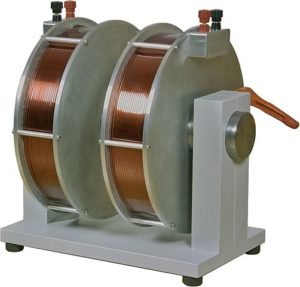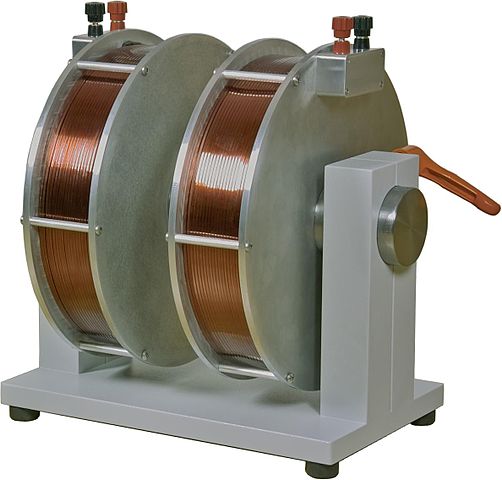
Why are electromagnets stronger than permanent magnets? Because the amount of current and the number of coils in the copper wire can increase the strength of an electromagnet while a permanent magnet cannot be any more magnetic than it already is.
The strength of a magnet is measured in different ways, but one way is with tesla. Tesla was an Austrian physicist, and the unit was named after him. A standard fridge magnet has a strength of roughly 0.001 tesla. Earth’s magnetic field has a strength of 0.00005 tesla. An MRI magnet has a strength of 1.5 tesla.
The strongest permanent magnet is a mix of neodymium, iron, and boron. It is so strong that two magnets attracting each other could easily sever a human finger or break a bone. The strongest neodymium-iron-boron magnets can have 1.5 tesla which makes it over a thousand times stronger than a regular kitchen magnet. A 2 gram magnet that is 8 mm by 5 mm can lift 1.7 kgs. These magnets are very strong, but they are the strongest permanent magnets that it is possible to buy.
Permanent magnets are called permanent magnets because the atoms in them have permanently aligned in the same direction, giving them a persistent magnetic field. Neodymium-iron-boron magnets have a very strong crystalline structure which keeps the atoms pointing in the same direction, making them strong. It also has 4 unpaired electrons that are all spinning in the same direction. Iron only has 3 unpaired electrons. These electrons create the magnetic field that makes the magnet so strong.
So, why can’t permanent magnets ever be as strong as electromagnets? An electromagnet is not a permanent magnet. It is only magnetic so long as the electric current is switched on. They are made from a copper wire wrapped around a piece of metal. The metal at the core of the magnet is usually lead, but it doesn’t have to be, and the wire is usually copper. Iron is used because it is very permeable, which means it allows the magnetic field to pass through it. And copper is usually used because it has a very low resistance. The copper wire is wrapped very tightly around the iron core and the current is switched on. Before the power is turned on, all of the atoms in the iron core point in different directions. When the power is switched on, they all snap into alignment. The current travels through the copper coil and the iron core starts to absorb electrons. These electrons all spin in the same direction as the rest of the electrons in the core, increasing its magnetic field. The strength of the magnetic field can be increased by putting more current through the wire or by wrapping the copper wire more tightly. However, at some point, the iron will be saturated with electrons and the magnet will have reached its limit. It is not possible to get a strength of more than 2 tesla from an iron core. It is possible to make an electromagnet stronger by changing the metal it is made out of.
It is possible to make electromagnets even more powerful if you can supercool them. Copper wire has a very low resistance, but it does still have a resistance. That means the electrons in the electric current bump into atoms in the wire and are lost as heat. This loss means that not all of the current can be used to power the magnet. When the temperature of a metal is reduced, the atoms stop moving so much and resistance goes down. At supercooled temperatures, close to absolute zero, the atoms stop moving at all and resistance becomes zero. If a magnet can be cooled down to -271.3℃ using liquid helium, the wire will have no resistance and the electromagnet can be stronger. Researchers in China managed to make an electromagnet that was capable of 45 tesla and a group of scientists in Japan managed to make a 1,200 tesla electromagnet but it exploded after 40 microseconds.
So, electromagnets are stronger than permanent magnets because the electric current adds more electrons that increase the magnetic field of the metal. A permanent magnet can never be stronger than the electrons that are already in it. Electromagnets can also be even stronger if they are supercooled. And this is what I learned today.
Image By Antennamax – Own work, CC BY-SA 3.0, https://commons.wikimedia.org/w/index.php?curid=15457022
Sources
https://sciencing.com/strong-standard-magnet-6853786.html
https://www.apexmagnets.com/news-how-tos/differences-n-ratings-neodymium-magnets/
https://www.kjmagnetics.com/blog.asp?p=magnet-grade
https://en.wikipedia.org/wiki/Neodymium_magnet
https://sciencing.com/electromagnet-temporary-magnet-6483660.html
https://www.stanfordmagnets.com/how-to-make-magnets-stronger.html
https://magnummagnetics.com/blog/how-to-measure-magnet-strength/
https://qeprize.org/winners/the-worlds-strongest-permanent-magnet
https://spectrum.ieee.org/magnetic-field-record-set-with-a-bang-1200-tesla
https://newatlas.com/physics/worlds-strongest-steady-magnetic-field/


Pingback: What are rare earth metals? | I Learned This Today